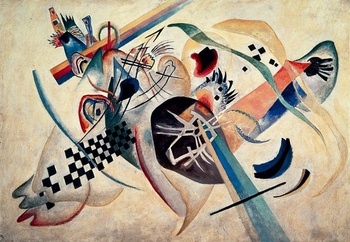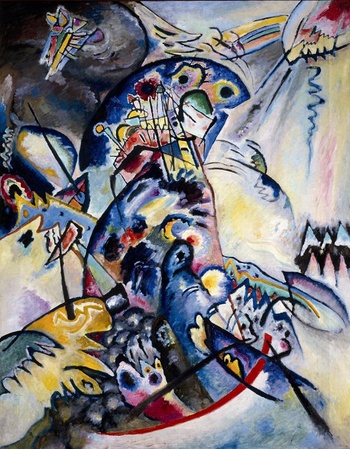(Wassily Kandinski, On White (I), 1920 © Russian Museum, Saint Petersburg)
Wassily Kandinsky is recognised as one of the first painters who made the switch from figurative to abstract art. The slightly overdone “Kandinsky & Russia” exhibition shows how that move fitted in with Kandinsky’s development as a painter and the evolution of the influences he was subject to.
Exactly one hundred years ago, Wassily Kandinsky (Moscow 1866–Neuilly-sur-Seine 1944) exhibited in the then famous Galerie Georges Giroux in Brussels; but the Belgian critics of the time, it seems, were not ready for him. The new exhibition focuses on the first, more revolutionary half of Kandinsky’s career as a painter, between 1901 and 1922. In that period he lived in Germany, until the outbreak of the First World War took him back to Russia. The exhibition ends (as far as Kandinsky is concerned) in 1922, when he fled the Soviet Union.
Kandinsky was already thirty years of age when he abandoned a promising career as a lawyer in order to apply colour to canvas. His writings show that it was, among other things, his introduction to the isbas of northern Russia – the simple but very colourful little wooden houses of the common people – that steered him in that direction. What appealed to Kandinsky in the isbas, apart from the range of colours, was the authenticity of this art of the people, in which he found great spiritual value. Via his father’s Mongolian origins, Kandinsky was already familiar with shamanism – and anyone who looks at his work will surely detect in it a certain predilection for trance and detachment. It was not for nothing that his most important treatise on art, which dates from 1911, was entitled Concerning the Spiritual in Art.
Soul
The question that always comes up in relation to Kandinsky is whether or not it was in his work that the move to abstraction first took place. That discussion is as fruitless as it is pointless. For a start, colour is to the fore even in Kandinsky’s early figurative work: in Red Church, for example, or in River in Autumn from his Munich period (1901 to 1903), or in the work he did in the Bavarian town of Murnau under the influence of the French Fauves, such as Summer Landscape (1909).
Wassily Kandinsky: listening to colours


(Wassily Kandinski, Blue Crest, 1917 © Russian Museum, Saint Petersburg)
In 1911, it is true, around the time when he and Franz Marc set up the expressionist painters’ group known as Der Blaue Reiter, he produced Picture with a Circle, in which there is no sign of any figuration. But in the rich colours of Fuga (1914) and Blue Crest (1917), there are certainly still remnants of observable reality to be detected. Black Spot (1912), which is about “the awakening of the soul”, suggests what it is that Kandinsky is about. Abstraction, for him, was not a goal, but the means that led him away from outward appearance in the direction of what was inside. He associated certain colours with certain sounds and emotional values. In his painting he distinguished between “impressions”, “improvisations” (a sort of jam session with colour), and “compositions”, in which those improvisations were further developed. In all cases, Kandinsky’s own inner eye plays a role; he asks viewers, moreover, to detach themselves and look at his paintings in the same way as they listen to music. It is, of course, questionable whether that is feasible and whether Kandinsky’s emotional visions can be reproduced by the viewer. But the emancipation of form and colour achieved by this European Russian remains enjoyable, in any case.
Excess
The “Kandinsky & Russia” exhibition is the first fruit of the cooperation between the Museums of Fine Arts and the Museums of Art and History. That cooperation has, for example, made it possible to include icons from the latter and a balalaika from the Musical Instruments Museum. Add that to all the other works of art contributed by other international partners and the exhibition is in danger of sinking under its own weight. Showing Kandinsky’s Russian context is useful, but it would have been a better idea to present that separately from his work. His friend and collaborator the painting composer Arnold Schoenberg is also given a lot of space, while works from the Museum of Modern Art – closed by Michel Draguet, the current Director of the Museums of Fine Arts – have been added to illustrate what might be called Kandinsky’s Belgian heirs. This contextual material makes it more difficult to appreciate Kandinsky’s idiosyncratic endeavours and makes the exhibition as a whole rather academic. Worse still, the walls of the exhibition are filled with logos and quotations in bold lettering that overshadow the paintings alongside them.
Kandinsky & Russia • > 30/6, di/ma/Tu > zo/di/Su 10 > 18.30 (wo/me/We > 20.00), €6,50 > 17,50, Royal Museums of Fine Arts of Belgium, Regentsschapstraat 3 rue de La Régence, Brussel/Bruxelles, 02-508.33.33 (rsv.), 078-77.00.76 (tickets), www.expo-kandinsky.be
In 1911, it is true, around the time when he and Franz Marc set up the expressionist painters’ group known as Der Blaue Reiter, he produced Picture with a Circle, in which there is no sign of any figuration. But in the rich colours of Fuga (1914) and Blue Crest (1917), there are certainly still remnants of observable reality to be detected. Black Spot (1912), which is about “the awakening of the soul”, suggests what it is that Kandinsky is about. Abstraction, for him, was not a goal, but the means that led him away from outward appearance in the direction of what was inside. He associated certain colours with certain sounds and emotional values. In his painting he distinguished between “impressions”, “improvisations” (a sort of jam session with colour), and “compositions”, in which those improvisations were further developed. In all cases, Kandinsky’s own inner eye plays a role; he asks viewers, moreover, to detach themselves and look at his paintings in the same way as they listen to music. It is, of course, questionable whether that is feasible and whether Kandinsky’s emotional visions can be reproduced by the viewer. But the emancipation of form and colour achieved by this European Russian remains enjoyable, in any case.
Excess
The “Kandinsky & Russia” exhibition is the first fruit of the cooperation between the Museums of Fine Arts and the Museums of Art and History. That cooperation has, for example, made it possible to include icons from the latter and a balalaika from the Musical Instruments Museum. Add that to all the other works of art contributed by other international partners and the exhibition is in danger of sinking under its own weight. Showing Kandinsky’s Russian context is useful, but it would have been a better idea to present that separately from his work. His friend and collaborator the painting composer Arnold Schoenberg is also given a lot of space, while works from the Museum of Modern Art – closed by Michel Draguet, the current Director of the Museums of Fine Arts – have been added to illustrate what might be called Kandinsky’s Belgian heirs. This contextual material makes it more difficult to appreciate Kandinsky’s idiosyncratic endeavours and makes the exhibition as a whole rather academic. Worse still, the walls of the exhibition are filled with logos and quotations in bold lettering that overshadow the paintings alongside them.
Kandinsky & Russia • > 30/6, di/ma/Tu > zo/di/Su 10 > 18.30 (wo/me/We > 20.00), €6,50 > 17,50, Royal Museums of Fine Arts of Belgium, Regentsschapstraat 3 rue de La Régence, Brussel/Bruxelles, 02-508.33.33 (rsv.), 078-77.00.76 (tickets), www.expo-kandinsky.be
Read more about: Expo
Fijn dat je wil reageren. Wie reageert, gaat akkoord met onze huisregels. Hoe reageren via Disqus? Een woordje uitleg.